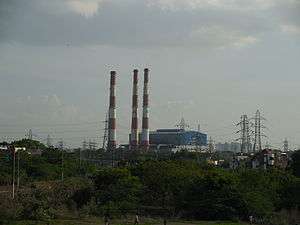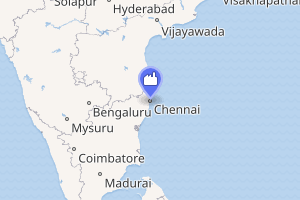GMR Vasavi Diesel Power Plant
GMR Vasavi Diesel Power Plant, owned by GMR Power Corporation Limited, was a private-owned power plant located in Basin Bridge, Chennai. It was a 200-MW LSHS (low sulphur heavy stock) fuel (processed from the residue of indigenous crude) power plant of the GMR Group.[1] The plant was based on two-stroke diesel engine technology from MAN B&W, Germany. It was the state's first plant commissioned by the private sector.[2] The plant was decommissioned in 2018.
| GMR Vasavi Diesel Power Plant | |
|---|---|
 GMR Vasavi plant as seen from Washermanpet | |

| |
| Country | India |
| Location | 1, Pulianthope High Road, Basin Bridge, Chennai 600 012, Tamil Nadu |
| Coordinates | 13°05′54″N 80°16′13″E |
| Status | Operational |
| Commission date | February 1999 (Phase I) |
| Decommission date | 2018 |
| Owner(s) | GMR Power Corporation Limited |
| Operator(s) | GMR Power Corporation Limited |
| Thermal power station | |
| Primary fuel | Diesel |
| Power generation | |
| Units operational | 4 x 50 MW |
| Nameplate capacity | 200 MW Planned: 320 MW |
| External links | |
| Website | www |
History
The 196-MW liquid fuel-fired power plant was commissioned in 1998 by the GMR Power Corporation on a 29-acre land leased by the Tamil Nadu Generation and Distribution Corporation for 20 years in March 1997.[2] The entire power generated at this plant was supplied to the Tamil Nadu State Electricity Board.[3] It was inaugurated by the then Chief Minister M. Karunanidhi in March 1999. Initially diesel was used as fuel, and later the plant used low sulphur heavy stock (LSHS). The Tangedco entered into a 15-year power purchase agreement with the plant. When it expired in 2014, it continued to purchase power from the plant till February 2015. After this, the agreement was not renewed.[2]
The plant
The plant was built on a 29-acre land and had four units of 49 MW each.[2]
Conservation
To prevent harmful pollutants from escaping into the atmosphere, the plant incorporated reverse osmosis for the final stage of purification. It also had a water conservation plant that processes about 5 percent of Chennai's sewage to produce water that was required to operate the plant, which was said to be the first of its kind in the country. The plant treated 7,200 cubic metres of raw sewage per day from Chennai MetroWater Supply and Sewage Board to produce 5,400 cubic metres of clean water for its own use.[3]
Expansion
Phase-I of the project consisting of 4 X 50 MW liquid fuel-based (diesel) power plant was in operation since February 1999.[4] In 2010, the plant planned conversion of Phase I project to a gas-based plant, in addition to initiate Phase II, which consisted of additional 120 MV gas-based combined cycle power plant. The expansion plans required additional land requirement of 2.5 acres, which was within the existing premises.[5]
Natural gas requirement for expansion was estimated at 0.60 million cubic metre per day at standard conditions, to be obtained from Krishna-Godavari basin. Natural gas required for conversion of existing diesel-based plant was estimated at 1.1 million cubic metre per day at standard conditions. About 3.48 MLD of water required for the expansion will be obtained from treated sewage water within the plant premises. An estimated 4.8 MLD of water will be required for conversion.[5]
There was also possibility of switching over the fuel of existing units from heavy oil to pyrolysis oil obtained from bio mass or urban garbage gasification.
These power generation units can be put to use for grid reserve service.[6][7]
Significance
The power plant remained significant as it catered to the requirements of vital civic utilities such as the Madras High Court, the Government Hospital, Secretariat, Central Railway Station, Egmore Children's Hospital and many important residential areas during emergencies.[2]
Awards
The plant had received ISO 14001 and OHSAS 18001 certifications from Det Norske Veritas. It had also received the Dr. M. S. Swaminathan Award for Environmental Protection for conserving the environment.[3]
Decommissioning
In 2018, the plant was decommissioned owing to high cost, with dismantling of the plant beginning in May 2018.[2]
See also
References
- Reddy, B. Dasarath (28 September 2012). "GMR to commission two power projects from October". Business Standard. Chennai: Business Standard. Retrieved 25 March 2014.
- Ramakrishnan, T. (29 August 2018). "Tamil Nadu's first private power plant shutting shop". The Hindu. Chennai: Kasturi & Sons. p. 2. Retrieved 2 September 2018.
- "GMR Power Corporation Limited". GMRgroup.in. Archived from the original on 25 March 2014. Retrieved 25 March 2014.
- "GMR Power Corporation Limited" (PDF). icra.in. Retrieved 25 March 2014.
- "120 MW combined cycle PP at Basin Bridge Purasawakkam by GMR Power Corporation Ltd". Thermal MoEF News. Retrieved 25 March 2014.
- Commercial Opportunities for Back-Up Generation and Load Reduction via National Grid, the National Electricity Transmission System Operator (NETSO) for England, Scotland, Wales and Offshore.
- "How to Turn Standby Generation Into Profit-Making Assets". Retrieved 13 March 2015.